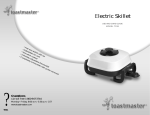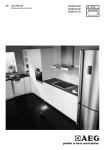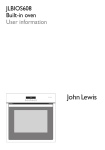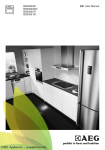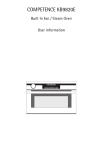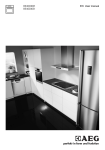Download user manual - VideoTesty.pl
Transcript
user manual Oven EOB67200X 2 electrolux Electrolux. Thinking of you. Share more of our thinking at www.electrolux.com Contents Safety instructions.................................. 3 Description of the Appliance .................. 4 Before Using for the first time ................. 7 Using the Oven ...................................... 8 Uses, Tables and Tips ............................ 26 Cleaning and Care................................. What to do if …..................................... Disposal ................................................ Service .................................................. 5 38 45 46 47 Subject to change without notice The following symbols are used in this user manual: 1 Important information concerning your personal safety and information on how to avoid damaging the appliance. 3 General information and tips 2 Environmental information electrolux 3 1 Safety instructions Electrical safety • This appliance must be only connected by a registered electrician. • In the event of a fault or damage to the appliance: Take the fuses out or switch off. • Repairs to the appliance must only be carried out by qualified service engineers. Considerable danger may result from improper repairs. If repairs become necessary, please contact our Customer Services or your dealer. Child Safety • Never leave children unsupervised when the appliance is in use. Safety whilst using • People (including children) who, because of their physical, sensory or mental capabilities or their inexperience or ignorance are not able to use the device safely, should not use this device without supervision or instruction by a responsible person. • This appliance is intended to be used for cooking, roasting and baking food in the home. • Take care when connecting electric appliances to sockets nearby. Do not allow connecting leads to come into contact with or to catch beneath the hot oven door. • Warning: Risk of burns! The interior of the oven becomes hot during use. • Using ingredients containing alcohol in the oven may create an alcohol-air mixture that is easily ignited. In this case, open the door carefully. Do not have embers, sparks or naked flames in the vicinity when opening the door. 3 Information on acrylamides According to the latest scientific knowledge, intensive browning of food, especially in products containing starch, can constitute a health risk due to acrylamides. Therefore we recommend cooking at the lowest possible temperatures and not browning foods too much. How to avoid damage to the appliance • Do not line the oven with aluminium foil and do not place baking trays, pots, etc. on the oven floor, as the heat that builds up will damage the oven enamel. • Fruit juices dripping from the baking tray will leave stains, which you will not be able to remove. For very moist cakes, use a deep tray. • Do not put any strain on the oven door when open. • Never pour water directly into the oven when it is hot. This could cause damage to or discolouration of the enamel. • Rough handling, especially around the edges of the front panel, can cause the glass to break. • Do not store any flammable materials inside the oven. These could ignite when the oven is switched on. • Do not store any moist foods inside the oven. This could damage the oven enamel. • After switching off the cooling fan, do not keep uncovered dishes in the oven. Moisture may condense in the oven interior or on the glass doors and may get into the units. 3 Note on enamel coating Changes in the colour of the oven’s enamel coating as a result of use do not affect the appliance’s suitability for normal and correct use. They therefore do not constitute a defect in the sense of the warranty law. 4 electrolux Description of the Appliance General Overview Control panel Door handle Light bar Oven door electrolux 5 Control Panel Oven display Function buttons Oven Oven Features All interior oven walls, except the floor of the oven, are coated with a special enamel (catalytic coating). Top heat and heating elements Oven lighting Shelf positions Meat probe connector Fat Filter Oven lighting Fan heating element Fan Bottom Heat Oven shelf runners, removable 6 electrolux Inside of door Roasting Pan For baking and roasting or as a pan for collecting fat. Meat probe On the inside of the oven door you will find the numbers of the different oven shelves. You will also find some brief information about the oven's functions, recommended shelves and temperatures for cooking the most popular dishes. Oven accessories Oven shelf For cookware, cake tins, roasts and grilled foods. Baking tray For cakes and biscuits. For determining exactly how far joints of meat are cooked. electrolux 7 Before Using for the first time Setting the Time 3 The oven only operates when the time After approx. 5 seconds, the clock stops flashing and the clock displays the time of day set. has been set. When the appliance is connected to the electrical supply or when there has been a power cut, Time flashes automatically. The appliance is now ready to use. Initial Cleaning Using the or button, set the current time. Before using the oven for the first time, you must clean it. 1 Important: Do not use sharp, abrasive cleaning agents! These could damage the surface. 3 For metal fronts, use normal commercially available cleaning agents. 1. 2. 3. 4. Open door. The oven light is activated. Remove all accessories and the slide-in grids and clean with warm water and washing-up liquid. Wipe the floor of the oven clean with warm washing-up solution and dry. Wipe the front of the appliance with a damp cloth. 8 electrolux Using the Oven The Electronic Oven Control Temperature/Clock Oven Functions Clock functions/Operating time Heat indicator On/Off Temperature check Oven function selection 3 General instructions • • • • • • Always switch the appliance on first by pressing the On/Off button. When the selected function is lit, the oven begins to heat up or the time set begins to count down. The Operating time display shows how long the oven has been operating. This display can only be seen if none of the clock functions Countdown , Cook time or End time are set. The oven light is switched on as soon as an oven function is selected. When the selected temperature is reached, an audible signal sounds. Switch off the oven using the On/Off button. Clock functions Meat probe Settings buttons electrolux 9 Selecting an oven function 1. Switch on the appliance using the On/ Off button. 2. Press the or button repeatedly until the desired oven function appears. • • A suggested temperature appears in the temperature display. If the suggested temperature is not changed within approx. 5 seconds, the oven starts to heat up. Checking the temperature Press the Temperature check button. The current oven temperature appears in the temperature display. Switching off the oven function 3 The oven function can be changed while the oven is working. Changing the oven temperature Press the or button, to raise or lower the temperature. The setting changes in steps of 5°C. To switch off the oven, press the or button repeatedly until no oven function is displayed any more. 3 If there has been no oven function and no clock function working for about 2 minutes, the appliance switches itself off automatically. But the bar display remains lit. To switch the light bars off, switch the appliance on using the On/Off button and switch it off again. 10 electrolux Switching the oven off 3 Heat indicator Warming up indicator Switch off the appliance using the On/Off button. 3 Cooling fan The fan switches on automatically in order to keep the appliance’s surfaces cool. When the oven is switched off, the fan continues to run to cool the appliance down, then switches itself off automatically. When the oven function has been switched on the bars that slowly light up one after the other indicate how far the oven has heated up. Residual heat indicator When the oven has been switched off, the bars that are still lit indicate the residual heat remaining in the oven. electrolux 11 Oven Functions The oven has the following functions: Oven function Application Convection with ring For roasting and baking on up to three levels at the same time. heating element Set the oven temperatures 20-40 °C lower than when using upper/lower heat. Conventional Cooking For baking and roasting on one oven level. Pizza Setting For baking on one oven level dishes that require more intensive browning and a crispy base. Set the oven temperatures 20-40 °C lower than when using Conventional. Convection grilling For roasting larger joints of meat or poultry on one level. The function is also suitable for gratinating and browning. Grill For grilling flat food items placed in the middle of the grill and for toasting. Dual grill For grilling flat food items in large quantities and for toasting. Bottom heat For baking cakes with crispy or crusty bases. Keep warm To keep dishes warm. Defrost For defrosting e. g. flans and gateaux, butter, bread, fruit or other frozen foods. Low temperature cooking For preparing especially tender, succulent roasts. 3 With the oven functions Pizza Setting , Conventional Cooking and Convection grilling the heating up time is shortened by the automatic function Speedcook. Inserting the Combination Shelf, Baking Tray and Roasting Pan Inserting the baking tray or roasting pan Insert baking tray or or roasting pan on the telescopic runners of the selected oven level so that the two holes engage on the front retaining pins on the telescopic runners. 12 electrolux Inserting the oven shelf: Inserting/Removing the Fat Filter Only use the fat filter when roasting to protect the rear heating elements from fat splashes. Insert the oven shelf so that the feet point downwards. Insert the oven shelf on the telescopic runners of the selected oven level. 3 The high rim around the oven shelf is an additional device to prevent cookware from slipping. Inserting the oven shelf and roasting pan together: Inserting the fat filter Hold the fat filter by the grip and insert the two mounts downwards into the opening on the rear wall of the oven (fan opening). Taking out the fat filter Hold the fat filter by the grip and unhook it. Lay the oven shelf on the roasting pan. Insert the oven shelf and the roasting pan on the telescopic runners of the selected oven level so that the two holes of the roasting pan engage on the front retaining pins on the telescopic runners. 3 To make it easier to insert the insertable component when runners are extended to different extents, lay the insertable component onto the runners at the back, push it in as far as the stop and then lower it onto the retaining pins at the front. electrolux 13 Meat probe For switching off the oven when the temperature at the centre of a roast reaches a set temperature. There are two temperatures to be set: – The oven temperature: See Roasting Table – The core temperature: See Meat probe Table 1 Important: Only the meat probe supplied may be used. If replacing, please use only original replacement parts. 1. Switch on the oven with the On/ Off button. 2. Push the tip of the meat probe right into the meat so that the tip is in the centre of the meat. The display changes to the current core temperature If the current core temperature has already been displayed, before the desired core temperature is set, then press the Selection button repeatedly, until the Meat probe function flashes and then carry out the setting. 3 The core temperature is displayed from 30°C. Select the desired oven function and temperature. As soon as the core temperature set is reached, an audible signal sounds and the oven switches itself off automatically. 5. 3. 4. Insert the meat probe plug into the socket on the oven side wall as far as it will go. Using the or button set the desired core temperature. 6. To switch off the signal, press any button. 14 electrolux 1 Warning: The meat probe is hot. There is a risk of being burned when removing the plug and the tip of the meat probe. 7. 8. Remove the meat probe’s plug from the socket and take the meat out of the oven. Switch off appliance. Checking or changing the core temperature – Press the Selection button repeatedly until the Meat probe function flashes and the core temperature set appears in the display. – If necessary, change the temperature using or . Checking or changing the oven temperature – If necessary, change the temperature using or . electrolux 15 Clock Functions Clock Functions Time display Clock Cook time/End time/Operating time Clock functions Meat probe Countdown To set a countdown. A signal sounds after the time has elapsed. This function does not affect the functioning of the oven. Cook time To set how long the oven is to be in use. End time To set when the oven is to switch off again. Time To set, change or check the time (See also section “Before Using for the First Time”). Selection buttons 16 electrolux 3 How to use the clock functions • • • • After a clock function has been selected, the corresponding function light flashes for about 5 seconds. During this period, the desired times can be set or modified using the or button. When the desired time has been set, the corresponding function light continues to flash for approx. 5 seconds, then remains illuminated. The set time begins to run. With Countdown the oven must also be switched on in order to set the clock function. By pressing and at the same time, the time set can be reset. 3 Checking the time set or remaining 2. Using the or countdown. button, set the desired After about 5 seconds, the display shows the time remaining. Press the Selection button repeatedly, until the appropriate clock function flashes and the time set or remaining is displayed. 2 Using residual heat with the Cook time and End time clock functions When the Cook time and End time clock functions are used, the oven switches the heating elements off, when 90% of the time set or calculated has elapsed. The residual heat present is used to continue the cooking process until the time set has elapsed (3 to 20 mins.). Countdown 1. Press the Selection button repeatedly until Countdown flashes. Countdown lights up When 90% of the time set has elapsed, a signal sounds. When the time has elapsed, a signal sounds for 1 minute. “00.00” and Countdown flash. To stop the flashing and the audible signal: Press any button. electrolux 17 Cook time 1. Select oven function and temperature. When the time has elapsed, “00.00” and Cook time flash. 2. A signal sounds for 2 minutes. The oven switches itself off. 3. Press the Selection button repeatedly until Cook time flashes. Using the or button, set the desired cooking time. Cook time lights up To stop the flashing and the audible signal: Press any button. 18 electrolux End time 1. Select oven function and temperature. When the time has elapsed, “00.00” and End time flash. 2. A signal sounds for 2 minutes. The oven switches itself off. 3. Press the Selection button repeatedly until End time flashes. Using the or button, set the desired switch-off time. End time lights up and the switch-off time is displayed. To stop the flashing and the audible signal: Press any button. electrolux 19 Cook time bined and End time com- Cook time and End time light up. 3 Cook time 1. 2. 3. and End time can be used simultaneously, if the oven is to be switched on and off automatically at a later time. Select oven function and temperature. Using the Cook time function, set the time required for cooking the dish, e. g.,: 1 hour. Using the End time function, set the time at which the dish is to be ready. e. g.,: at 14:05. The oven switches itself on automatically at the time calculated. e. g.,: at 13:05. When the set Cook time has elapsed, a signal sounds for 2 minutes and the oven switches itself off. e. g.: at 14:05. 20 electrolux Changing the Time 3 The time can only be modified, if the 1. 2. child safety device is deactivated, neither of the clock functions Cook time or End time nor any oven functions are set. Press the Selection button repeatedly until Time flashes.. Using the time. or button, set the current After approx. 5 seconds, the clock stops flashing and the clock displays the time of day set. The appliance is now ready to use. electrolux 21 Other functions Child safety device As soon as the child safety device is set, the appliance can no longer be switched on. Activating the child safety device 1. If necessary, switch on the appliance using the On/Off button. No oven function must be selected. 2. Press and hold the Selection and buttons at the same time, until “SAFE” appears in the display. The child safety device is now set. Cancelling the child safety device 1. If necessary, switch on the appliance using the On/Off button. 2. Press and hold the Selection and buttons at the same time, until “SAFE” disappears from the display. The child safety device is now cancelled and the appliance is again ready for use. Button lock To ensure that oven functions set are not accidentally altered. Activating the button lock 1. If necessary, switch on the appliance using the On/Off . 22 electrolux 2. 3. Select the oven function. Press and hold the Selection and buttons at the same time, until “LOC” appears in the display. The button lock is now engaged. Cancelling the button lock Press and hold the Selection and buttons at the same time, until “LOC” disappears from the display. The button lock is automatically lifted when the oven function is switched off. 3 Heat+Hold The Heat+Hold function keeps your prepared dish warm for 30 minutes, after the baking or roasting process is completed. This is helpful, for example, if your guests are late. Pre-condition for Heat+Hold: • Set temperature is above 80°C Switching on Heat+Hold 1. Set clock functions Cook time and/ or End time . 2. Press the Selection button repeatedly until the symbol Keep warm appears in the display. 3. Press the button. “00:30:” appears in the display. 4. As soon as the oven function is completed, a signal sounds and Heat+Hold starts. The oven function set runs at 80°C for 30 minutes. As soon as the 30 minutes with Heat+Hold has elapsed, the oven switches itself off. 3 Irrespective of an oven function being set, Heat+Hold remains active. You can change between the oven functions. Oven Automatic cut-out 3 If the oven not switched off after a cer- tain time, or if the temperature is not modified, it switches off automatically. The last temperature set appears in the temperature display. The oven switches itself off when the oven temperature is: 30 - 120°C 120 - 200°C 200 - 250°C 250 – max °C after after after after 12.5 hours 8.5 hours 5.5 hours 3 hours Using the appliance after an automatic cut-out Switch the oven off completely. It can then be switched on again. 3 The automatic cut-out is cancelled, if the clock function Cook time / End time or the oven function Low temperature cooking is set. electrolux 23 Mechanical door lock When the appliance is delivered the door lock is deactivated. door and plug the door trim (B) into the upper edge of the door Activating door lock 3 On the open side of the door trim (B) 1. Take hold of the door trim(B) on the upper edge of the door at both sides and press inwards to release the clip seal. Then remove the door trim by pulling it upwards. 2. Activate lever: Remove lever (1) and move 4mm to the left (2) and insert (3). there is a guide bar (C). This must be pushed between the outer door panel and the guide corner (D). The clip seal (E) must be snapped in. 3. Take hold of the door trim (B) at each side, position it on the inside edge of the 24 electrolux To open the oven door. 1. 2. 2. Demount lever: Remove lever (1). 3. Remove trim from the under side of the door trim (B)(2) and push in (3). 4. Take hold of the door trim(B) at each side, position it on the inside edge of the door and push the door trim (B) onto the upper edge of the door Keep lever pressed. Open the door. To close the oven Close door without pressing the lever. Deactivating door lock To deactivate the door lock, the lever is moved to the right again. Proceed as described above. 3 Switching off the appliance does not remove the mechanical door lock. Removing door lock 1. Take hold of the door trim(B) on the upper edge of the door at both sides and press inwards to release the clip seal. Then remove the door trim by pulling it upwards. electrolux 25 3 On the open side of the door trim(B) there is a guide bar(C). This must be pushed between the outer door panel and the guide corner(D). 5. The clip seal(E) must be snapped in. Close the oven door. 26 electrolux Uses, Tables and Tips Baking 3 baking trays: Oven function: Convection with ring heating element or Conventional Cooking Baking tins • For Conventional Cooking dark metal and non-stick tins are suitable. • For Convection with ring heating element bright metal tins are also suitable. Oven levels • Baking with Conventional Cooking is possible on one oven level. • With Convection with ring heating element you can bake on up to 3 baking trays at the same time: 1 baking tray: oven levels 1, 3 and 5 General instructions • Insert the tray with the bevel at the front. • With Conventional Cooking or Convection with ring heating element you can also bake with two tins next to one another on the oven shelf at the same time. This does not significantly increase baking time. e.g. oven level 3 1 cake tin: e.g. oven level 1 2 baking trays: z. g., oven levels 1 and 3 3 When frozen foods are used the trays in- serted may distort during cooking. This is due to the large difference in temperature between the freezing temperature and the temperature in the oven. Once the trays have cooled the distortion will disappear again. How to use the baking tables The tables give the required temperature settings, baking times and oven shelf levels for a selection of typical dishes. • Temperatures and baking times are for guidance only, as these will depend on the consistency of pastry, dough or mixture, the amount and the type of baking tin. • We recommend using the lower temperature the first time and then if necessary, for example, if a deeper browning is required, or baking time is too long, selecting a higher temperature. • If you cannot find the settings for a particular recipe, look for the one that is most similar. • If baking cakes on baking trays or in tins on more than one level, baking time may be extended by 10-15 minutes. • Moist recipes (for example, pizzas, fruit flans, etc.) are baked on one level. electrolux 27 • • Cakes and pastries at different heights may brown at an uneven rate at first. If this occurs, please do not change the temperature setting. Different rates of browning even out as baking progresses. Your new oven may bake or roast differently to your previous appliance. So adapt your normal settings (temperature, cooking times) and oven shelf levels to the recommendations in the following tables. 2 With longer baking times, the oven can be switched off about 10 minutes before the end of baking time, to make use of the residual heat. Unless otherwise stated, the values given in the tables assume that cooking is started with the oven cold. Baking table Baking on one oven level Type of baking Oven function Oven level Temperature °C Time Hr: Mins. Baking in tins Ring cake or brioche Convection with ring heating element 1 150-160 0:50-1:10 Madeira cake/fruit cakes Convection with ring heating element 1 140-160 1:10-1:30 Sponge cake Convection with ring heating element 1 140 0:25-0:40 Sponge cake Conventional Cooking 1 160 0:25-0:40 1) Flan base - short pastry Convection with ring heating element 3 Flan base - sponge mixture Convection with ring heating element 3 150-170 0:20-0:25 Conventional Cooking 1 170-190 0:50-1:00 Apple pie (2tins Ø20cm, diagonally off set) Convection with ring heating element 1 160 1:10-1:30 Apple pie (2tins Ø20cm, diagonally off set) Conventional Cooking 1 180 1:10-1:30 Convection with ring heating element 1 160-180 0:30-1:10 Conventional Cooking 1 170-190 1:00-1:30 Apple pie Savoury flan (e. g, quiche lorraine) Cheesecake 160-180 0:10-0:25 Cakes/pastries/breads on baking trays Plaited bread/bread crown Conventional Cooking 3 170-190 0:30-0:40 Christmas stollen Conventional Cooking 3 160-1802) 0:40-1:00 Bread (rye bread) -first of all -then Conventional Cooking 1 2301) 160-180 0:25 0:30-1:00 Cream puffs/eclairs Conventional Cooking 3 160-1701) 0:15-0:30 3 1) 0:10-0:20 Swiss roll Conventional Cooking 180-200 28 electrolux Type of baking Oven function Oven level Temperature °C Time Hr: Mins. Cake with crumble topping (dry) Convection with ring heating element 3 150-160 0:20-0:40 Buttered almond cake/sugar cakes Conventional Cooking 3 190-2101) 0:15-0:30 Fruit flans (made with yeast dough/ sponge mixture)3) Convection with ring heating element 3 150 0:35-0:50 Fruit flans (made with yeast dough/ sponge mixture)2) Conventional Cooking 3 170 0:35-0:50 Convection with ring heating element 3 160-170 0:40-1:20 Yeast cakes with delicate toppings (e. g, quark, cream, custard) Conventional Cooking 3 160-1801) 0:40-1:20 Pizza (with a lot of topping)2) Convection with ring heating element 1 180-2001) 0:30-1:00 Pizza (thin crust) Convection with ring heating element 1 200-2201) 0:10-0:25 Unleavened bread Convection with ring heating element 1 200-220 0:08-0:15 Tarts (CH) Convection with ring heating element 1 180-200 0:35-0:50 Short pastry biscuits Convection with ring heating element 3 150-160 0:06-0:20 Viennese whirls Convection with ring heating element 3 140 0:20-0:30 Viennese whirls Conventional Cooking 3 1601) 0:20-0:30 Biscuits made with sponge mixture Convection with ring heating element 3 150-160 0:15-0:20 Pastries made with egg white, meringues Convection with ring heating element 3 80-100 2:00-2:30 Macaroons Convection with ring heating element 3 100-120 0:30-0:60 Biscuits made with yeast dough Convection with ring heating element 3 150-160 0:20-0:40 Puff pastries Convection with ring heating element 3 170-1801) 0:20-0:30 Rolls Convection with ring heating element 3 1601) 0:20-0:35 Rolls Conventional Cooking 3 1801) 0:20-0:35 Fruit flans made with short pastry Biscuits electrolux 29 Type of baking Oven function Oven level Temperature °C Time Hr: Mins. Small cakes (20per tray) Convection with ring heating element 3 1401) 0:20-0:30 Small cakes (20per tray) Conventional Cooking 3 1701) 0:20-0:30 1) Pre-heat the oven 2) Pre-heat the oven 3) Use the drip tray or roasting tray Baking on more than one oven level Type of baking Convection with ring heating element Convection with ring heating element Temperature in °C Time Hours: Mins. Shelf positions from bottom 2 levels 3 levels Cakes/pastries/breads on baking trays Cream puffs/Eclairs 1/4 --- 160-1801)) 0:35-0:60 Dry streusel cake 1/3 --- 140-160 0:30-0:60 Biscuits/small cakes/pastries/rolls Short pastry biscuits 1/3 1/3/5 150-160 0:15-0:35 Viennese whirls 1/3 1/3/5 140 0:20-0:60 Biscuits made with sponge mixture 1/3 --- 160-170 0:25-0:40 Biscuits made with egg white, meringues 1/3 --- 80-100 2:10-2:50 Macaroons 1/3 --- 100-120 0:40-1:20 Biscuits made with yeast dough 1/3 --- 160-170 0:30-0:60 Puff pastries 1/3 --- 170-1801) 0:30-0:50 Rolls 1/4 --- 160 0:30-0:55 Small cakes (20per tray) 1) Pre-heat the oven 1/4 --- 140 1) 0:25-0:40 30 electrolux Tips on Baking Baking results Possible cause Remedy The cake is not browned enough underneath Wrong oven level Place cake lower The cake sinks (becomes soggy, lumpy, streaky) Oven temperature too high Use a slightly lower setting Baking time too short Set a longer baking time Baking times cannot be reduced by setting higher temperatures Too much liquid in the mixture Use less liquid. Pay attention to mixing times, especially if using mixing machines Oven temperature too low Set oven temperature higher. Baking time too long Set a shorter baking time Oven temperature too high and baking time too short Set a lower oven temperature and a longer baking time Mixture is unevenly distributed Spread the mixture evenly on the baking tray Grease filter is inserted Take out the grease filter Temperature too low Use a slightly higher oven setting Grease filter is inserted Take out the grease filter Cake is too dry Cake browns unevenly Cake does not cook in the baking time given Pizza Setting table Shelf position Temperature °C Time Hr: Mins. Pizza (thin crust) 1 180 - 2001) 20 - 30 Pizza (with a lot of topping) 1 180 - 200 20 - 30 Tarts 1 180 - 200 45 - 60 Spinach flan 1 160 -180 45 - 60 Quiche Lorraine 1 170 - 190 40 - 50 Quark flan, round 1 140 - 160 60 - 90 Quark flan on tray 1 140 - 160 50 - 60 Apple cake, covered 1 150 - 170 50 - 70 Vegetable pie 1 160 - 180 50 - 60 Unleavened bread 1 250 - 2701) 10 - 20 Puff pastry flan 1 160 - 180 1) 40 - 50 Flammekuchen (Pizza-like dish from Alsace) 1 250 - 2701) 12 - 20 1 2001) 15 - 25 Type of baking Piroggen (Russian version of calzone) 1) Pre-heat the oven 180 - electrolux 31 Bakes and gratins table Dish Oven function Shelf position Temperature °C Time Hours mins. Pasta bake Conventional Cooking 1 180-200 0:45-1:00 Lasagne Conventional Cooking 1 180-200 0:25-0:40 Vegetables au gratin1) Convection grilling 1 160-170 0:15-0:30 Baguettes topped with melted cheese1) Convection grilling 1 160-170 0:15-0:30 Sweet bakes Conventional Cooking 1 180-200 0:40-0:60 Fish bakes Conventional Cooking 1 180-200 0:30-1:00 Convection grilling 1 160-170 0:30-1:00 Stuffed vegetables 1) Pre-heat the oven Frozen ready meals table Food to be cooked Oven function Shelf position Temperature °C Time Frozen pizza Conventional Cooking 3 as per manufacturer’s instructions as per manufacturer’s instructions Chips1) (300-600 g) Convection grilling 3 200-220 as per manufacturer’s instructions Baguettes Conventional Cooking 3 as per manufacturer’s instructions as per manufacturer’s instructions Fruit flans Conventional Cooking 3 as per manufacturer’s instructions as per manufacturer’s instructions 1) Comments: Turn chips 2 or 3 times during cooking Roasting Oven function: Conventional Cooking or Convection grilling Insert the grease filter when roasting! Roasting dishes • Any heat-resistant ovenware is suitable to use for roasting (please read the manufacturer's instructions). • Large roasting joints can be roasted directly in the roasting tray or on the oven shelf with the roasting tray placed below it. • For all lean meats, we recommend roasting these in a roasting tin with a lid. This will keep the meat more succulent. • All types of meat, that can be browned or have crackling, can be roasted in the roasting tin without the lid. 3 Tips on using the roasting chart • • • • The information given in the following table is for guidance only. We recommend cooking meat and fish weighing 1 kg and above in the oven. To prevent escaping meat juices or fat from burning on to the pan, we recommend placing some liquid in the roasting pan. If required, turn the roast (after 1/2 - 2/3 of the cooking time). Baste large roasts and poultry with their juices several times during roasting. This will give better roasting results. 32 electrolux • You can switch the oven off about 10 minutes before the end of the roasting time, in order to utilise the residual heat. Roasting table Type of meat Quantity Ovenfunction Shelf position Temperature °C Time Hours mins. 1 200-250 2:00-2:30 Beef Pot roast 1-1.5 kg Conventional Cooking per cm. of thickness Roast beef or fillet - rare per cm. of thickness Convection grilling 1 190-2001) 0:05-0:06 - medium per cm. of thickness Convection grilling 1 180-190 0:06-0:08 - well done per cm. of thickness Convection grilling 1 170-180 0:08-0:10 Shoulder, neck, ham joint 1-1.5 kg Convection grilling 1 160-180 1:30-2:00 Chop, spare rib 1-1.5 kg Convection grilling 1 170-180 1:00-1:30 Meat loaf 750 g-1 kg Convection grilling 1 160-170 0:45-1:00 Porkknuckle (precooked) 750 g-1 kg Convection grilling 1 150-170 1:30-2:00 1 kg Convection grilling 1 160-180 1:30-2:00 1.5-2 kg Convection grilling 1 160-180 2:00-2:30 Leg of lamb, roast lamb 1-1.5 kg Convection grilling 1 150-170 1:15-2:00 Saddle of lamb 1-1.5 kg Convection grilling 1 160-180 1:00-1:30 up to 1 kg Conventional Cooking 3 220-2501) 0:25-0:40 Saddle of venison 1.5-2 kg Conventional Cooking 1 210-220 1:15-1:45 Haunch of venison 1.5-2 kg Conventional Cooking 1 200-210 1:30-2:15 Pork Veal Roast veal Knuckle of veal Lamb Game Saddle of hare, leg of hare electrolux 33 Type of meat Quantity Ovenfunction Shelf position Temperature °C Time Hours mins. Poultry Poultry portions 200-250g each Convection grilling 1 200-220 0:35-0:50 Half chicken 400-500g each Convection grilling 1 190-210 0:35-0:50 Chicken, poulard 1-1.5 kg Convection grilling 1 190-210 0:45-1:15 Duck 1.5-2 kg Convection grilling 1 180-200 1:15-1:45 Goose 3.5-5 kg Convection grilling 1 160-180 2:30-3:30 Turkey 2.5-3.5 kg Convection grilling 1 160-180 1:45-2:30 Turkey 4-6 kg Convection grilling 1 140-160 2:30-4:00 1-1.5 kg Conventional Cooking 1 210-220 0:45-1:15 Fish (steamed) Whole fish 1) Pre-heat the oven Meat probe Table Food to be Cooked Meat Core Temperature Beef Rib steak or fillet steak rare medium well done 45 - 50 °C 60 - 65 °C 70 - 75 °C Pork Shoulder of pork, ham joint, neck 80 - 82 °C Chop (saddle), smoked pork loin 75 - 80 °C Meat loaf 75 - 80 °C Veal Roast veal 75 - 80 °C Knuckle of veal 85 - 90 °C Mutton / lamb Leg of mutton 80 - 85 °C Saddle of mutton 80 - 85 °C Roast lamb, leg of lamb 70 - 75 °C Game 34 electrolux Food to be Cooked Meat Core Temperature Saddle of hare 70 - 75 °C Leg of hare 70 - 75 °C Whole hare 70 - 75 °C Saddle of venison 70 - 75 °C Leg of venison 70 - 75 °C Low temperature cooking 1 Important: Insert the grease filter Oven function: Low temperature cooking With the oven function Low temperature cooking meat becomes beautifully tender and remains particularly succulent. We recommend Low temperature cooking for pieces of tender, lean meat and fish. Low temperature cooking is not suitable for e. g. pot roasts or fatty pork roasts. The oven heats up to the selected or pre-set temperature. When this temperature is reached, an acoustic signal sounds. After 10 minutes the oven switches to a lower temperature to continue cooking. We recommend120°C for smaller pieces of meat, e. g. steaks 150°C is recommended for larger pieces of meat, e. g. fillet of beef. 3 When using the oven function Low tem- when roasting. 1. 2. 3. perature cooking always cook dishes uncovered without a cover. Sear the meat in a pan over a very high heat. Place meat in a roasting dish or directly on the oven shelf with a tray underneath to catch the fat. Place in the oven. Select oven function Low temperature cooking change the temperature, if necessary, and cook until done. (See table.) 3 The oven function Low temperature cooking is not possible together with the clock functions Cook time and End time Table: Low temperature cooking Weight g Setting Shelf position Total time mins. Roast beef 1000-1500 150°C 1 90-110 Fillet of beef 1000-1500 150°C 3 90-110 Roast veal 1000-1500 150°C 1 100-120 Steaks 200 - 300 120°C 3 20-30 Food to be cooked electrolux 35 Grill sizes Oven function: Grill or Dual grill with maximum temperature setting 1 Important: Always grill with the oven 3 • • • • door closed. The empty oven should always be preheated with the grill functions for 5 minutes. For grilling, place the shelf in the recommended shelf position. Always insert the tray for collecting the fat into the first shelf position from the bottom. The grilling times are guidelines. Grilling is particularly suitable for flat pieces of meat or fish. Grilling table Grilling time Food to be grilled Oven level 1st side 2nd side Burgers 4 8-10 mins. 6-8 mins. Pork fillet 4 10-12 mins. 6-10 mins. Sausages 4 8-10 mins. 6-8 mins. Fillet steaks, veal steaks 4 6-7 mins. 5-6 mins. Fillet of beef, roast beef (approx. 1 kg) 3 10-12 mins. 10-12 mins. Toast1) 3 4-6 mins. 3-5 mins. Toast with topping 3 6-8 mins. --- 1) Do not pre-heat Defrosting Oven function: Defrost (no temperature setting) • Unwrap the food and place it on a plate on the oven shelf. • Do not cover with a plate or bowl, as these can substantially lengthen the defrosting time. • For defrosting, place the shelf in the 1st oven level from the bottom. 36 electrolux Defrosting table Defrosting time mins. Further defrosting time (mins.) Chicken, 1000 g 100-140 20-30 Place the chicken on an upturned saucer placed on a large plate Turn halfway through Meat, 1000 g 100-140 20-30 Turn halfway through Meat, 500 g 90-120 20-30 Turn halfway through Trout, 150g 25-35 10-15 --- Strawberries, 300g 30-40 10-20 --- Butter, 250g 30-40 10-15 --- Cream, 2 x 200g 80-100 10-15 Cream can also be whipped when still slightly frozen in places 60 60 Dish Gateau, 1400g Comments --- Drying Oven function: Convection with ring heating element • Use oven shelves covered with greaseproof paper or baking parchment. • You get a better result if you switch the oven off halfway through the drying time, open the door and leave the oven to cool down overnight. • After this, finish drying the food to be dried. Food to be dried Temperature in °C Oven level 1 level 2 levels Time in hours (Guideline) Vegetables Beans 60-70 3 1/4 6-8 Peppers (strips) 60-70 3 1/4 5-6 Vegetables for soup 60-70 3 1/4 5-6 Mushrooms 50-60 3 1/4 6-8 Herbs 40-50 3 1/4 2-3 Plums 60-70 3 1/4 8-10 Apricots 60-70 3 1/4 8-10 Fruit electrolux 37 Food to be dried Temperature in °C Oven level 1 level 2 levels Time in hours (Guideline) Apple slices 60-70 3 1/4 6-8 Pears 60-70 3 1/4 6-9 Keep warm For keeping food warm. The temperature regulates itself automatically to 80 °C. Oven level: 3 also see section - Operating the oven - under other functions Heat+Hold. Making preserves Oven function: Bottom heat • For preserving, use only commercially available preserve jars of the same size. • Jars with twist-off or bayonet type lids and metal tins are not suitable. • When making preserves, the first shelf position from the bottom is the one most used. • Use the shelf for making preserves. There is enough room on this for up to six 1-litre preserving jars. • The jars should all be filled to the same level and clamped shut. • Place the jars on the baking tray in such a way that they are not touching each other. • Pour approx. 1/2 litre of water into the baking tray so that sufficient moisture is produced in the oven. • As soon as the liquid starts to pearl in the first jars (after about 35-60 minutes with 1 litre jars), switch the oven off or reduce the temperature to 100°C (see table). 38 electrolux Preserves table The times and temperatures for making preserves are for guidance only. Preserve Temperature in°C Cooking time until Continue to cook simmering at 100°C in mins. in mins. Soft fruit Strawberries, blueberries, raspberries, ripe gooseberries 160-170 35-45 --- Unripe gooseberries 160-170 35-45 10-15 160-170 35-45 10-15 160-170 50-60 5-10 Mushrooms 160-170 40-60 10-15 Cucumbers 160-170 50-60 --- Mixed pickles 160-170 50-60 15 Kohlrabi, peas, asparagus 160-170 50-60 15-20 Beans 160-170 50-60 --- Stone fruit Pears, quinces, plums Vegetables Carrots1) 1) 1) Leave standing in oven when switched off Cleaning and Care 1 Warning: First switch off the appliance and let it cool down before carrying out any cleaning. Warning: For safety reasons, do not clean the appliance with steam blasters or highpressure cleaners. Attention: Do not use any corrosive cleaning fluids, sharp objects or stain removers. Do not clean the glass oven door with abrasive fluids or metal scrapers, which could scratch the surface. The glass could crack and shatter. Outside of the appliance • Wipe the front of the appliance with a soft cloth and a solution of hot water and washing up liquid. • • For metal fronts, use normal commercially available cleaning agents. Please do not use scouring agents and abrasive sponges. Oven interior 1 Warning: When cleaning, no oven func- tions must be selected and the oven must have cooled down. Cleaning The catalytic coated walls are self-cleaning. They absorb splashes of fat whilst the oven is operating. To aid this self-cleaning process, we recommend that you heat up the oven at regular intervals without placing food inside. 1. The oven light will switch on automatically when the oven door is opened. electrolux 39 2. 3. 4. 5. 6. Remove all slide-in parts from the oven. Wipe the floor of the oven clean with warm washing-up solution and dry. Set the oven temperature to 250°C. After an hour, switch off the oven. Wipe away any remaining grime with a damp, soft sponge. Oven shelf runner The shelf support rails on the left and right hand sides of the oven can be removed for cleaning the side walls. Removing the shelf support rails 1 Caution! Do not use oven spray or 3 abrasive cleaning agents. Do not use soap or other cleansing agents. The catalytic sheeting may otherwise be damaged. After long periods of use, the catalytic coating may become slightly discoloured. This has no effect on the catalytic properties. Accessories First pull the front of the rail away from the oven wall and then unhitch at the back. Wash all slide-in units (shelf unit, baking tray, shelf support rails etc.) after each use and dry well. Soak briefly to make them easier to clean. Fat Filter 1. 2. Clean the fat filter in hot water and washing up liquid or in the dishwasher. Badly burned on soiling can be removed by boiling the filter in a little water to which 2-3 tablespoonsful of dishwasher cleaner has been added. Non-stick accessories Clean accessories with a soft sponge or cloth in hot water and washing-up liquid. 3 Bright spots in the coating do not mean that the surface is damaged. 1 Important: Do not use any aggressive or scouring cleaning agents, spray oven cleaners, steel soap pads or hard objects such as knives or sharp-edged scrapers. These destroy the coating. 1 Important: Do not clean these accessories in the dishwasher. The non-stick properties would be lost as a result. Fitting the shelf support rails 1 When inserting the rails, make sure that the retaining pins on the telescopic runners are pointing to the front. 40 electrolux To install, first reattach the rails at the back, then put them into position at the front and press them into place. 2. 3. If necessary: replace with 25 watt, 230 V, 300 °C heat-resistant oven lighting. Refit the glass cover. Changing side oven light/Cleaning glass cover Cleaning the oven shelf runner Clean oven shelf runners with hot water and washing up liquid. 1 Important: The oven shelf runners 1 cannot be cleaned in the dishwasher. Important: On no account grease telescopic runners. 1. 2. 4. Remove the left shelf support rail. Remove the glass cover with the aid of a narrow, blunt implement (e.g., teaspoon) and clean it. If necessary: replace bulb with a 25 watt, 230 V, 300 °C heat-resistant, oven light bulb. Refit the glass cover. 5. Insert the shelf support rail. 3. Oven Lighting 1 Warning: Risk of electric shock! Prior to changing the oven light bulb: – Switch off the oven! – Disconnect from the electricity supply. 3 Place a cloth on the oven floor to protect the oven light and glass cover. Changing the oven light bulb/cleaning the glass cover 1. Remove the glass cover by turning it anti-clockwise and then clean it. electrolux 41 Oven door For easier cleaning of the oven interior the oven door of your appliance can be taken off its hinges. Removing the oven door from its hinges 1. Open the oven door as far as it will go. oven at an upwards angle (Take care: It is heavy). 3 Lay the oven door with the outer side 2. Undo the clamping levers (A) on both door hinges fully. 3. Close the oven door as far as the first position (approx. 45°). 4. Take hold of the oven door with a hand on each side and pull it away from the facing downwards on something soft and level, for example, a blanket in order to prevent scratches. Hanging the oven door back on its hinges 1. From the handle side take hold of the oven door with a hand on each side and hold at an angle of approx. 45°. Position the recesses on the bottom of the oven door on the hinges on the oven. Let the door slide down as far as it will go. 42 electrolux 2. Open the oven door as far as it will go. 3. Fold up the clamping levers (A) on both door hinges back into their original positions. 4. Removing door glass panels 1. Open the oven door as far as it will go. 2. Undo the clamping levers (A) on both door hinges fully. 3. Close the oven door as far as the first position (approx. 45°). 4. Take hold of the door trim (B) on the upper edge of the door at both sides and press inwards to release the clip seal. Then remove the door trim by pulling it upwards. 5. Take hold of the door glass panels on their upper edge one after the other and Close the oven door. Oven door glass The oven door is fitted with four panels of glass mounted one behind the other. The inner panels can be removed for cleaning. 1 Important Rough handling, especially around the edges of the front panel, can cause the glass to break. electrolux 43 pushed between the outer door panel and the guide corner (D). take them out of the guide by pulling them upwards. Cleaning the door glass panels Clean the door glass panels thoroughly with a solution of water and washing up liquid. Then dry them carefully. Putting the door glass panels back. 1. From above insert the door glass panels one after the other into the door profile at the bottom edge of the door at an angle and lower them. 3. 3 The two smaller panels first, then the 2. larger panel. Take hold of the door trim (B) at each side, position it on the inside edge of the door and plug the door trim (B) into the upper edge of the door. 3 On the open side of the door trim (B) there is a guide bar (C). This must be The clip seal (E) must be snapped in. Open the oven door as far as it will go. 44 electrolux 4. Fold up the clamping levers (A) on both door hinges back into their original positions. 5. Close the oven door. electrolux 45 What to do if … Problem The oven does not heat up Possible cause Remedy The oven has not been switched on Switch the oven on The clock has not been set Set the current time on the clock The required settings have not been Check the settings set The oven’s automatic cut-out has been triggered. See Automatic cut-out The house wiring fuse (in the fuse box) has tripped Check fuse. If the fuses trip several times, please call a qualified electrician The oven lighting is not operat- The oven light bulb is faulty ing Replace oven bulb The oven is not heating up. Time is lit. Demo mode is on. Keep Selection button pressed for 2 seconds, then within 2 seconds press and hold Selection and buttons for 2 seconds F11 appears in the clock display The meat probe has short circuited or the plug of the meat probe is not firmly in position in the socket Insert the plug of the meat probe as far as it will go into the socket on the side wall of the oven An error code not listed above Fault in the electronics appears in the time display If you are unable to remedy the problem by following the above suggestions, please contact your local Service Force Centre. 1 Warning! Repairs to the appliance are only to be carried out by qualified service engineers. Considerable danger to the user may result from improper repairs. 3 If the appliance has been operated incorrectly, the engineer's visit will be chargeable, even during the warranty period. 3 Advice on cookers with metal fronts: Because of the cold surface at the front of the cooker, opening the oven door during (or just after) baking or roasting may cause the glass to steam up. Switch off the appliance via the house fuse or the safety switch in the fuse box and switch it on again. If displayed again, please contact the Customer Care Department 46 electrolux Disposal 2 Packaging material The packaging materials are environmentally friendly and can be recycled. The plastic components are identified by markings, e.g. >PE<, >PS<, etc. Please dispose of the packaging materials in the appropriate container at the community waste disposal facilities. 2 Old appliance W 1 on the product or on its The symbol packaging indicates that this product may not be treated as household waste. Instead it shall be handed over to the applicable collection point for the recycling of electrical and electronic equipment. By ensuring this product is disposed of correctly, you will help prevent potential negative consequences for the environment and human health, which could otherwise be caused by inappropriate waste handling of this product. For more detailed information about recycling of this product, please contact your local city office, your household waste disposal service or the shop where you purchased the product. Warning: So that the old appliance can no longer cause any danger, make it unusable before disposing of it. To do this, disconnect the appliance from the mains supply and remove the mains cable from the appliance. electrolux 47 Service In the event of technical faults, please first check whether you can remedy the problem yourself with the help of the operating instructions (section “What to do if…”). If you were not able to remedy the problem yourself, please contact the Customer Care Department or one of our service partners. In order to be able to assist you quickly, we require the following information: – – – Model description Product number (PNC) Serial number (S No.) (for numbers see rating plate) – Type of fault – Any error messages displayed by the appliance So that you have the necessary reference numbers from your appliance at hand, we recommend that you write them in here: Model description: ..................................... PNC: ..................................... S No: ..................................... www.electrolux.com 387 996 596-A-020609-01



















































